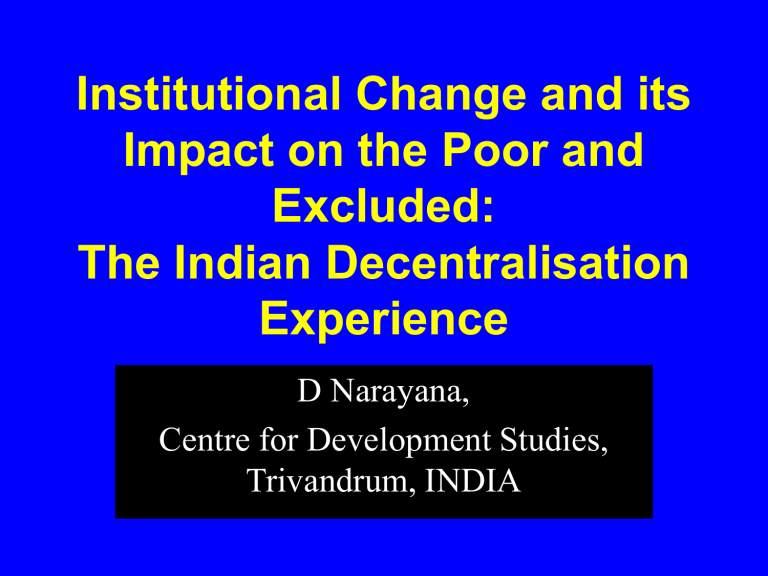The Indian Decentralisation Experience

Institutional Change and its
Impact on the Poor and
Excluded:
The Indian Decentralisation
Experience
D Narayana,
Centre for Development Studies,
Trivandrum, INDIA
Implications of Panchayati Raj/ Municipalities as the Third Tier of Governance in India
UNION
|
' |--------------------------- STATE --------------------------
|
|
|----- ------|--
PANCHAY
--------------|
MUNICIPALI
|
|
|
|
ATI RAJ
|
3. Zilla
TY
|
Municipal
|
|
|
|
|
|
Panchayat
|
2. Block
Panchayat
|
1. Gram
Panchayat
Corporation
|
Municipal
Council
|
Nagar
Panchayat
|
|
|
|
|
|
|
GRAM
SABHA
|
WARD
MEETINGS
|
|
|
|
|
|
'|------------Autonomous Councils for Tribal Areas--------|
2
Salient Features of Local Governance
Persons chosen by direct election to fill seats
Seats shall be reserved for SC/ST
One-third the number of seats reserved for women
Offices of chairperson shall also be reserved for women/SC/ST
Shall plan for economic development and social justice
OECD Conference 3
Institutional Change for
Participatory
Democracy
•Representation for socially and gender disadvantaged
•Gram Sabha (village assembly) has to approve plans and budgets
•In conception Panchayats are local self governments
•In practice size and structure of Panchayats vary across Indian states
•Devolution of functions, powers, and resources vary
•Some are truly local governments; some mere agents
OECD Conference 4
Research Questions
• Do women, the socially excluded, like scheduled castes and tribe, and the poor actively participate in the LSGIs?
• What are the determinants of their participation?
• What are the policy conclusions?
• Question is addressed by taking three states:
• Kerala, Tamil Nadu and Madhya Pradesh
• Falling into three distinct size structure of
LSGIs
OECD Conference 5
Variation in Participation by Aspect, Group and State
Aspect of Participation
Women Scheduled Castes and Tribes
Poor
Attendance in election meetings
TN KER MP TN KER MP TN KER MP
VL
Participation in contesting L
VL
L
L
L
-
-
VH
-
-
-
VL VH
VL -
-
-
Participation in Gram Sabha
Raise issues in Gram
Sabha
Sign petitions
-
L
-
VL
-
VL
-
-
-
-
VH
H
H
-
-
-
-
L
VH
H
H
-
-
Contact Elected
Representatives
Contact Block/ District
Panchayat
L
L
L VL -
- - -
-
-
L - H -
- - VH -
OECD Conference 6
Lower Participation by Women
• F Literacy (%<5 years schooling)
-MP(70), TN(30), KER(20)
-GG: MP(20), TN and KER (0)
• F NP Readership: MP(7), TN(49), KER(69)
-GG 20,10,10
• SHG membership: MP(15), TN and KER (>30)
-Regular meetings: 0, 67, 75
-%Discussing PRI: 0, 3, 55
• Membership of Political parties: 2,1,11
-GG: 0,30,17
OECD Conference 7
Participation by SC/ST vs. Others
Literacy: MP, TN- no difference; KER- SC lower
NP Readership: MP, TN- no diff.; KER- SC lower
MP, TN: ST/SC on par with OBC economically
SHG membership: MP- ST<OBC; TN- SC=OBC;
KER- SC>OBC,FC
Political Party membership: MP, TN- no diff;
KER- SC>>OBC,FC
OECD Conference 8
Participation by the Poor vs Rich
• F Literacy: MP- no difference; TN, KER-
Poor < Rich;
• F NP Readership: MP- low for all; TNpoor<rich; KER- poor<<rich
• SHG membership: MP- poor<<rich;
TN,KER- no difference
• Pol Party membership: MP- no difference;
TN- poor<<rich; KER-poor>>rich
OECD Conference 9
Participation of the Poor and Excluded
• Literacy and NP readership is necessary but not sufficient to ensure participation
• A vibrant civil society does not necessarily lead to higher participation
• A vibrant political society leads to higher participation
• Lack of political mobilisation leads to the exclusion of the poor and elite capture
• Size of local governments has no influence but structure has
OECD Conference 10










